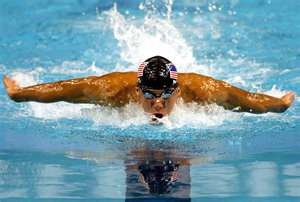
Swimming is a sport governed by the Fédération Internationale de Natation (FINA).
History
Competitive swimming in Europe began around 1800 CE, mostly in the form of the freestyle. In 1873, Steve Bowyer introduced the trudgen to Western swimming competitions, after copying the front crawl used by Native Americans. Due to a British disregard for splashing, trudgen employed a scissor kick instead of the front crawl's flutter kick. Swimming was part of the first modern Olympic games in Athens in 1896. In 1902, Richard Cavill introduced the front crawl to the Western world. In 1908, the Fédération Internationale de Natation (FINA), which is the current governing body of the swimming world, was formed. The butterfly stroke was developed in the 1930s and was at first a breaststroke variant, until it was accepted as a separate style in 1952.
In 1912, Fanny Durack (of Australia) became the first female to win an Olympic gold medal, for the 100-yard freestyle.
Competition
Competitive swimming became popular in the nineteenth century. The goal of competitive swimming is to constantly improve upon one's time(s), or to beat the competitors in any given event. However, some professional swimmers who do not hold a national or world ranking are considered the best in regard to their technical skills. Typically, an athlete goes through a cycle of training in which the body is overloaded with work in the beginning and middle segments of the cycle, and then the workload is decreased in the final stage as the swimmer approaches the competition in which he or she is to compete in. This final stage is often referred to as "shave and taper"; the swimmer has tapered down his or her workload to be able to perform at their optimal level. At the very end of this stage, before competition, the swimmer shaves off all exposed hair for the sake of reducing drag and having a sleeker and more hydrodynamic feel in the water.
Swimming is an event at the Summer Olympic Games, where male and female athletes compete in 16 of the recognized events each. Olympic events are held in a 50-meter pool, called a long course pool.
There are forty officially recognized individual swimming events in the pool; however the International Olympic Committee only recognizes 32 of them. The international governing body for competitive swimming is the Fédération Internationale de Natation ("International Swimming Federation"), better known as FINA.
Open water
In open water swimming, where the events are swum in a body of open water (lake or sea), there are also 5 km, 10 km and 25 km events for men and women. However, only the 10 km event is included in the Olympic schedule, again for both men and women. Open-water competitions are typically separate to other swimming competitions with the exception of the World Championships and the Olympics.
Swim styles
In competitive swimming, four major styles have been established. These have been relatively stable over the last 30–40 years with minor improvements. The four main strokes in swimming are:
* Freestyle
* Breaststroke
* Backstroke
* Butterfly
Although there are only four main swimming events to compete with there is a fifth considered stroke, the underwater dolphin kick used of of every wall if chosen
Dolphin kick
In the past two decades, the most drastic change in swimming has been the addition of the underwater dolphin kick. This is used to maximize the speed at the start and after the turns. The first successful use of it was by David Berkoff at the 1988 Olympics, where he swam most of the 100 m backstroke race underwater and broke the world record on the distance during the preliminaries. Another swimmer to use the technique was Denis Pankratov at the 1996 Olympics in Atlanta, where he completed almost half of the 100 m butterfly underwater to win the gold medal. In the past few years,[when?] American competitive swimmers have shown the most use of the underwater dolphin kick to gain advantage, most notably Olympic and World medal winners Michael Phelps and Ryan Lochte.
While the dolphin kick is mostly seen in middle-distance freestyle events and in all distances of backstroke and butterfly, it is not usually used to the same effect in freestyle sprinting. That changed with the addition of the so-called sharkskin suits until the European Short Course Championships in Rijeka, Croatia in December 2008. There, Amaury Leveaux set new world records of 44.94 seconds in the 100 m freestyle, 20.48 seconds in the 50 m freestyle and 22.18 in the 50 m butterfly. Unlike the rest of the competitors in these events, he spent at least half of each race underwater using the dolphin kick.
While underwater dolphin kicking is allowed in freestyle, backstroke and butterfly, its use is not permitted in the same way in the breaststroke. In 2005, a new rule was formed stating that an optional downward dolphin kick may be used off the start and each turn, and it must occur during the breaststroke pullout. Any other dolphin kick will result in disqualification.
New rules were established to curtail excessive use of underwater dolphin kicks in freestyle, backstroke and butterfly. Currently, performing the dolphin kick past 15 meters results in a disqualification.


